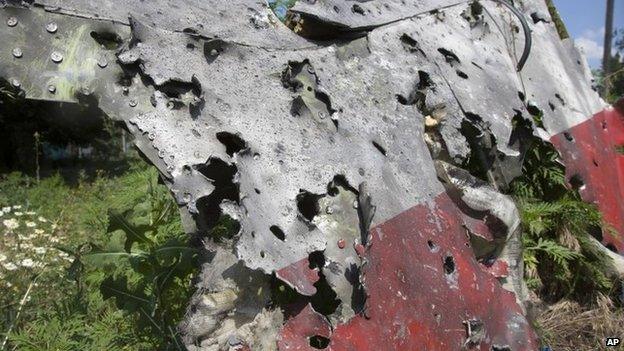MH17 disaster: Missile fragment 'found at crash site'
- Published
John Sweeney follows the trail of what eyewitnesses describe as a Russian BUK missile system
Dutch broadcaster RTL says it has new evidence that the Malaysia Airlines plane shot down over Ukraine last July was hit by a surface-to-air missile.
Forensic analysis of a metal fragment found at the crash site, external of flight MH17 by a journalist indicated it was from the warhead of a Russian-made Buk.
This would support the theory the plane was downed by pro-Russian rebels, over whose territory the plane was flying.
All 298 people on board the flight from Amsterdam to Kuala Lumpur were killed.
A preliminary report, external published in September by the Dutch Safety Board, which is investigating the crash, said the plane broke up after being penetrated by "high-velocity objects".
Additional material 'welcome'
On Thursday, RTL reported that a metal fragment was recovered by Dutch journalist Jeroen Akkermans several months ago from the crash site, near the village of Hrabove in eastern Ukraine.
The broadcaster said it had the shrapnel tested by international forensic and weapons experts, who concluded that it had come from the warhead of a 9M317 Buk missile.
Nicholas de Larrinaga of IHS Jane's told RTL: "From the hour-glass form we can gather all the characteristics of an impact of a 9N314 warhead fragment. This fits perfectly."

Investigators said the plane was hit by shrapnel from a fragmentation weapon such as a Buk
The Ukrainian government and the West have accused the Russian authorities of supplying the separatists with Buk missile launchers.
The claim is supported by witness statements, as well as photographs and videos. However, it has been denied by Moscow, which has suggested that Ukrainian forces were responsible for the crash.
The Dutch prosecutor leading the criminal case said earlier this month that a Buk missile may have hit the airliner, although it was "too early to rule out other possibilities".
In reaction to RTL's report, the Dutch Safety Board noted that the link to flight MH17 had to be demonstrated for each piece of evidence, in part because it crashed in a conflict zone.
"The investigation into the cause of the accident is ongoing and is focusing on many more sources than just the pieces of shrapnel," a statement on its website said, external.
"Additional material for investigation is welcome for this, but it is important that it be irrefutably demonstrated that there is a relationship between any material and the aeroplane that crashed."
The results of the Dutch Safety Board investigation are due to be released in October.